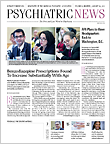Almost 1 in 5 children and adolescents who initiated use of long-acting stimulants (LAS) for attention-deficit/hyperactivity disorder (ADHD) also received second-generation antipsychotics concurrently for at least 14 days, according to a report analyzing data on children enrolled in Medicaid published online December 15, 2014, in Psychiatric Services in Advance.
Approved and off-label indications of second-generation antipsychotics influenced concurrent use in pediatric ADHD, according to the report.
Rajender Aparasu, Ph.D., of the Department of Pharmaceutical Health Outcomes and Policy, University of Houston College of Pharmacy, and colleagues performed a retrospective longitudinal analysis of 2003–2007 Medicaid data from four states for children and adolescents aged 6 to 17 who were diagnosed as having ADHD and started on LAS treatment.
They used Medicaid Analytic eXtract (MAX) data from California, Illinois, New York, and Texas for five years (January 2003 to December 2007). The MAX files include a personal summary file, an inpatient file, a prescription drug file, and an “other” therapy file.
Exposure to second-generation agents was defined as a prescription claim for clozapine, risperidone, olanzapine, quetiapine, ziprasidone, paliperidone, and aripiprazole at any time during one year after January 2003. Concurrent use or polypharmacy involving LAS and second-generation antipsychotics was defined as simultaneous receipt of both medications for at least 14 days. Statistical analysis examined predisposing, enabling, and need factors associated with concurrent use.
Among the 61,793 children who initiated LAS treatment for ADHD, 19.2 percent received LAS and second-generation antipsychotics concurrently for at least 14 days. Overall, the average length of concurrent use was 130 days.
Some predisposing and enabling factors influenced concurrent use; for instance, the odds of receiving LAS and second-generation antipsychotics concurrently were higher among boys than among girls, a finding that can be attributed to the fact that boys have higher rates of behavioral disorders compared with girls.
Interestingly, the study also found that black youth were more likely to receive concurrent treatment than white youth, a finding that is not consistent with past research. “The higher odds of concurrent use among blacks than among whites may be attributed to socioeconomic characteristics of the Medicaid study population,” the authors suggested.
Other factors influencing concurrent use of the two drugs were the presence of Food and Drug Administration–approved indications (schizophrenia, bipolar disorder, and psychosis) and off-label indications (oppositional defiant disorder, pervasive developmental disorder, tic disorder, and personality disorder).
“Overall, the concurrent use was similar to the findings from cross-sectional studies that examined use of multiple psychotropic medications among children and adolescents by using national survey data,” the researchers stated. “The current study’s findings also revealed that, in general, users of concurrent LAS and antipsychotics had significantly higher rates of psychiatric comorbidities and mental health–related hospitalization compared with users of only LAS. Second-generation antipsychotics are approved for a variety of indications, such as schizophrenia, major depressive disorder, mixed or manic bipolar episodes, and behavioral treatment of autism. A few controlled studies have found some support for use of risperidone to reduce disruptive behavior and to improve hyperactivity and inattention among patients with ADHD. Therefore, although the concurrent use of LAS and antipsychotics is common in pediatric ADHD, it may be used to treat patients with other psychiatric comorbidities or those with higher disease severity.
“In the light of limited evidence, there is an urgent need to examine the safety and effectiveness of concurrent use of LAS and second-generation antipsychotics among children and adolescents with ADHD,” they stated. ■
“Concurrent Use of Stimulants and Second-Generation Antipsychotics Among Children With ADHD Enrolled in Medicaid” can be accessed
here.
